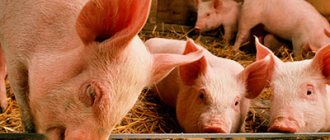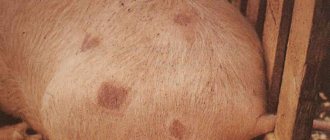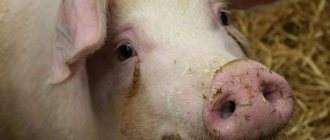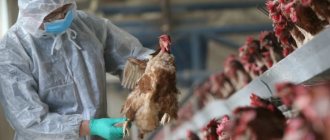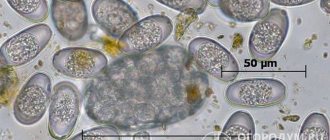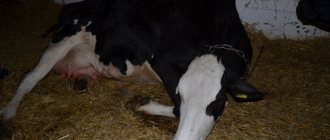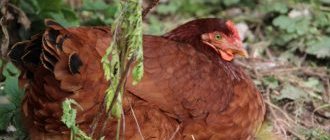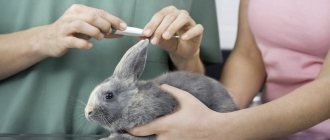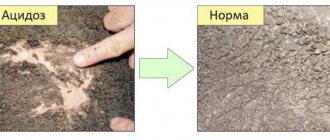What kind of disease is this
The disease is caused by an infectious pathogen - Pasteurella multicida. The pathogen was identified and described by Pasteur, and the disease was named after him.
Penetrating into the body, the rod reaches the lymph and begins to actively multiply. Toxins produced as a result of the vital activity of Pasteurella multicida increase vascular permeability and cause inflammation of the mucous membranes and lymph nodes. Most bacteria accumulate in the lungs, which are rich in oxygen. The capillaries are damaged, septicemia and swelling of the subcutaneous tissue and intermuscular tissues are recorded. In severe forms of pasteurellosis, necrotic foci form in the lungs and other organs.
In pigs, multiple lesions of the body are recorded - changes in the joints, mucous membranes of the eyes, and disturbances in the gastrointestinal tract. The most severe forms develop in piglets, whose mortality rate is 75-100%. The mucus blocks the respiratory tract, the pigs sneeze and cough, the infection spreads throughout the livestock and is quickly transmitted from sick individuals to healthy ones.
Information: pig pasteurellosis is characterized by seasonality, epidemics are usually recorded in early spring and autumn. The disease is widespread in the central part of Russia.
Diagnostics
At the first suspicion of pasteurellosis, you should immediately call a veterinarian. Only he will be able to correctly diagnose the disease and prescribe appropriate treatment.
Important! It is necessary to take samples of biological material from a sick individual. Blood is drawn and scraped from the mucous membrane. The collected samples are studied in a laboratory setting.
However, in the event of the death of an animal, a number of examinations are also required. This will prevent the spread of the disease and begin timely treatment of infected individuals.
After death, it is necessary to take a piece of the infected lung and lymph node. Samples of the liver, kidneys and spleen are also delivered to the laboratory. If a small specimen dies, the whole carcass is brought in for examination.
Sources and causes of the disease
Factors provoking the epidemic are:
- crowding of pigs indoors;
- excessive air humidity;
- incorrectly chosen diet, lack of vitamins;
- improper maintenance - dirt in the pigsty, rare removal of manure (the stick remains active in manure for up to 72 days);
- a decrease in immunity after vaccinations against infectious diseases;
- weakened livestock, low immunity in pigs.
Most often, pigs become infected from a sick individual that appears on the premises. Other sources of infection are:
- carriers of the bacilli (many pigs show resistance - they themselves do not get sick, but can infect others);
- bloodsucking insects;
- rodents;
- other domestic animals (rabbits, chickens);
- feed, water, soil, containing Pasteurella multicida;
- feces of sick animals that have not been removed from the pigsty.
See also
Systems and methods for keeping pigs at home for beginnersRead
Pigs can become infected through airborne droplets (they inhale air containing the secretions of sick animals) and by eating contaminated food or water. Some pigs become infected through the skin through insect bites or minor injuries. More often than others, pigs who have had other infections and have lost their immunity suffer from pasteurellosis.
Sources and routes of infection
The disease can be spread by:
- sick or recovered animals that remain carriers;
- healthy pigs that have been in contact with sick ones;
- bloodsucking insects, flies, wild birds, rodents;
- contaminated feed, soil, utensils, water, milk;
- slaughterhouse waste that has not been disinfected.
The bacterium is localized in the respiratory tract, nasal passages, trachea, and lungs.
Therefore, the disease can be transmitted through saliva, exhaled air, nasal discharge, and excrement. The situation is aggravated by non-compliance with sanitary and hygienic standards of housing and feeding, and crowded conditions of animals. The disease usually becomes more active during cool and rainy seasons, as well as after vaccination, when the animal’s body is weakened. Find out how to treat diarrhea, sarcoptic mange and worms in piglets.
Symptoms and forms of the disease
The incubation period depends on the form and ranges from 1 to 14 days. The development of the disease in pigs can be detected by the following signs:
- feverish condition;
- temperature rise - up to 41° and above;
- inflamed skin and mucous membranes of the eyes;
- signs of intoxication - shortness of breath, loss of appetite, lethargy;
- joint inflammation, swelling, pain;
- mucus in the nasal passages, coughing, sneezing.
There are septic (hemorrhagic septicemia) and secondary forms of the disease. The septic type has the following flow forms:
- Super acute. Rapid increase in signs of intoxication, sharp rise in temperature, heart failure. Death of the animal within 1-3 days.
- Spicy. Catarrhal signs - cough, mucus from the nose, bluish skin develops, shortness of breath. Death in 3-8 days. With timely treatment, survival rate is up to 40%.
- Subacute. Pigs experience gastrointestinal disturbances, diarrhea, pneumonia, and cyanosis.
- Chronic. Over time, the temperature normalizes. Pigs lose weight, cough persists, and joint changes occur. The condition lasts up to 1.5-2 months, up to 70% of sick pigs die.
The secondary form develops after infections in pigs; it is often not possible to diagnose it in time. Most animals die within a week from the onset of the disease.
Signs
Acute pasteurellosis in pigs can be determined by the following signs:
- an increase in the animal’s body temperature to 41-42 degrees;
- loss of appetite;
- rapid breathing;
- general weakness;
- dyspnea;
- nasal discharge;
- chills.
Blueness of the piglet's ears and mucous membranes are also the main symptoms of this dangerous disease. Very often, animals infected with pasteurellosis experience the so-called sitting dog pose.
If the disease is not treated within the first days, then soon (after about 8 days) the animal will most likely die.
In addition, the disease in most cases manifests itself as multiple hemorrhages under the skin and conjunctivitis. Sometimes a pig may experience diarrhea.
Diagnostic methods
It is difficult to diagnose the disease on your own; only experienced pig farmers can do it. When the chest is compressed, bluish spots remain on the skin of pigs, which indicate damage to the capillaries and congestion. Pigs experience severe pain when pressure is applied.
Diagnostics include:
- study of the clinical picture;
- taking into account the epidemiological factor;
- excretion of the pathogen - through blood, mucus, pus from abscesses, cerebrospinal fluid.
Sowing is carried out in laboratory conditions using rabbits, mice, and pigeons. The carcasses of dead animals must be examined to confirm pasteurellosis. It is important to differentiate the disease, since several infections (erysipelas, salmonellosis, anthrax) occur with a similar clinical picture.
Clinical signs of the disease
Signs appear immediately after the end of the incubation period, which lasts from a day to two weeks. The clinical picture of pasteurellosis is caused by exposure to toxins secreted by the pathogen.
Once pathogenic bacteria enter the body, they multiply quickly, migrate to the lymphatic and circulatory systems, causing numerous lesions of small blood vessels and, as a result, the occurrence of edema in different organs and parts of the body.
The animal's immunity weakens, the temperature rises, a large amount of antibodies are released into the blood, which leads to infection and thickening of the blood, the development of heart failure, pneumonia, and gastrointestinal dysfunction.
One of the signs of pasteurellosis is the appearance of swelling on the body.
Based on the nature and speed of progression, the primary (septic) and secondary forms of the disease are differentiated.
Septic form
Septic pasteurellosis is considered as an independent disease - hemorrhagic septicemia and, in turn, has varieties:
- Super-acute form. It is characterized by signs common to systemic inflammatory processes. The animals' temperature suddenly and rapidly rises to 41-42 °C, and breathing becomes heavy. Animals lose interest in food, their general condition deteriorates sharply, and they quickly get tired. Cardiac activity is impaired, bluish spots appear on the ears, legs, thighs, and abdomen. The throat becomes noticeably swollen, and the mucous membranes of the respiratory tract become inflamed. Animals die 24-48 hours after the first symptoms appear.
- Acute form. Its clinical picture is similar to the symptoms of the hyperacute form.
The temperature rises, the animal is depressed, and its appetite disappears. Breathing becomes more frequent, shortness of breath and nasal discharge appear. Cyanotic spots appear on the snout, ears, and lower abdomen. The acute variety is characterized by an increased level of leukocytes in the blood. In hyperacute and acute forms, bluish spots appear on the pig’s body. In the case of a protracted course of the disease, the symptoms of pneumonia become especially noticeable - the formation of fibrous (scar) tissue, severe cough, rapid heartbeat, swelling of the extremities, purulent mucous discharge from the nose. In most cases, death occurs, usually the animal dies within 5-8 days. - Subacute form. It is characterized by: fever, severe chills, severe, painful cough, shallow breathing, pigs moan when exhaling. Blue spots appear on different parts of the body, purulent discharge, and stool disturbances. Death occurs within 5-8 days.
- In rare cases, acute and subacute pasteurellosis becomes chronic. An animal that has recovered from the disease lags behind its healthy relatives in development, periodically its condition worsens, coughing, joint tumors, and eczema appear. As a rule, such animals are fattened and slaughtered after 2-3 months.
Secondary form
Pasteurellosis often occurs as a secondary form of serious diseases of pigs - plague (including African plague), erysipelas, and salmonellosis. The symptoms of pasteurellosis (pneumonia, leukemia) are “mixed” with the signs of the underlying disease, which complicates making a correct diagnosis and developing a treatment strategy. A sick animal usually dies within 5-8 days.
[adsp-pro-6]
Methods for treating porcine pasteurellosis
The first step in treatment is to isolate sick pigs and provide comfortable living conditions with enhanced, balanced nutrition. For treatment use:
- Anti-pasteurella serum. It is administered along with antibiotics, to which pasteurella is sensitive.
- Antibacterial drugs. Long-acting substances are used (dibiomycin, ecmonovocillin). Antibiotics of a number of penicillins, tetracyclines, cephalosporins, and sulfonamides are also used.
- Solutions of glucose or chloride to restore water and electrolyte balance.
- Vitamins.
- Symptomatic therapy. To treat developed cardiac disorders, Mildronate or other drugs are used.
See also
What herbs can and cannot be given to piglets, a list of useful and dangerous plantsRead
For severe cases, blood transfusions are used, and for breathing problems, inhalations are used.
Quarantine measures are being introduced to protect against the spread of infection:
- isolation of contact pigs - import-export, walking is prohibited;
- vaccination against the disease and preventive antibiotic therapy, especially in piglets;
- disinfection of the pigsty, regular cleaning;
- burning of dead individuals.
The quarantine center is closed after 14 days; if pasteurellosis has been stopped, no new cases appear.
Reasons for the development of pasteurellosis in pigs
Pasteurella enters the room along with food and is carried by insects. It is possible to purchase an already infected piglet or an adult who has recovered from the disease. The bacterium enters the animal's body through food, water, breathing and through the skin.
A favorable environment for the rapid reproduction of pasteurella is a room with insufficient sanitary conditions, in which temperature and humidity indicators are not observed. Poorly fed animals with weak immune systems are especially vulnerable. Further spread of the bacterium occurs through various secretions (feces, saliva, etc.).
Pasteurellosis is especially dangerous in piglets at an early age, when the body is most susceptible to infections.
Vaccine against the disease
Vaccination helps prevent mass infection of pigs. Piglets are vaccinated at the following times, making intramuscular injections:
- 12-15 days from birth, if the sow does not have immunity;
- 30 days if the mother is vaccinated.
Repeated vaccination against the disease is carried out after 35-40 days. To protect livestock from pasteurellosis, several types of vaccines have been developed, including associated ones (PPS, PPD against salmonellosis, cocci).
The effect of vaccination lasts up to six months, then pigs are vaccinated again to maintain immunity and prevent disease.
Vaccination
In order to stop the development of the disease among pigs, it is necessary to carry out routine vaccination. Today this is the most reliable way to prevent the infectious process among livestock.
A special vaccine against pasteurellosis consists of cattle blood.
In modern veterinary medicine the following drugs are used:
- inactivated DPP vaccine;
- vaccine against salmonellosis, streptococcus and pasteurellosis in piglets;
- SPS-2 vaccine.
Piglets born from unvaccinated sows are vaccinated on days 12-15. If the females have been vaccinated, then their piglets are vaccinated on the 30th day of life. The serum is reintroduced after 35-40 days.
Immunity after vaccination lasts for 6 months. After the specified period is completed, it is necessary to repeat the administration of the vaccine.
The introduction of a vaccine does not necessarily guarantee the protection of a pig, because its immunity can be undermined by poor nutrition and insufficiently comfortable living conditions. That is why it is important to take care of creating adequate living conditions for animals.
Pasteurellosis is a dangerous infectious disease that affects pigs. The causative agent of the disease causes changes in the structure of internal organs and most often leads to the death of the sick individual. The most effective method of prevention is regular vaccination of pigs.
0
0
Copy link
General preventive measures
Vaccines do not provide a 100% guarantee against infection, although they protect pigs well from pasteurella infection. Prevention measures against pasteurellosis:
- vaccination of the entire livestock in a timely manner;
- regular disinfection of premises where sick pigs appeared;
- in case of illness - compliance with quarantine measures;
- do not import animals from problem farms;
- upon import - placing animals in quarantine;
- regular inspection;
- keeping pigs clean, regular removal of manure;
- refusal of surgical procedures on the farm (castration);
- avoiding contact with animals from other farms, stray or wild animals;
- extermination of rodents and insects – frequent spreaders of the disease;
- nutritious nutrition to support immunity.
The best way to prevent any disease is vaccination and proper housing conditions. The costs of vaccines against pasteurellosis are recouped by healthy and vigorous livestock and a high-quality product. Don't forget that humans can also become infected with pasteurella, so protecting pigs will help keep farm staff healthy.
Treatment
Only a doctor can prescribe diagnosis and treatment. As a rule, drugs are prescribed in a complex manner. As aids, the veterinarian prescribes:
- long-acting antibiotics (dibiomycin);
- antibacterial drugs (novarsenol);
- sulfonamides (trichopolum, biseptol);
- symptomatic (trimetazidine).
But drug treatment alone is not enough. It is necessary to carry out a number of complex measures. The main task of the breeder is to weaken and destroy the pathogen. To do this, you will need to remove toxins from the body and improve the overall functioning of all internal organs.
The sick individual must be placed in a separate pen and provided with proper conditions in the new place of residence. It is necessary to create an optimal level of humidity and temperature. The premises must be treated in advance.
At the time of illness, it is necessary to change the diet. Food must be high in calories. The water container must be rinsed. The water is changed regularly. It is worth introducing vitamins B and C, glucose and cocarboxylase into the menu of artiodactyls.
The room must be regularly ventilated. It is required to regularly monitor the well-being of the wards.
In severe cases of the disease, blood transfusions are performed and oxygen inhalations are prescribed. If prescribed treatment is followed, pigs successfully fight the disease. After recovery, they gain immunity. However, the body's protective functions will remain in effect for about a year. Do not neglect the vaccination regimen.
What can become a source of infection?
Pasteurellosis usually appears due to poor hygiene or through contact with another infected person. Large animals are usually the main source of infection. They release infection into the air, saliva and their own feces. The disease can also enter the body through dirty water or the soil on which pigs live or graze. In addition, not only artiodactyl animals can spread the disease, but also insects, rodents and birds.
Infection occurs through air or contact. Infection also often occurs through the stomach: a person eats or drinks already contaminated food. In addition, experts are sure that infection often occurs through wounds, and it does not matter what size they are. Pasteurella spp is a strong disease, its rods instantly multiply and begin to infect all cells of the body. The disease immediately suppresses all the work of phagocytes, which is why the body cannot resist the disease. Toxins begin to be produced in all the main systems of the body, which is why the percentage of vascular permeability increases sharply. As a result, this all leads to such serious diseases as:
- a variety of swelling;
- diathesis;
- poor blood clotting;
- a sharp increase in the percentage of bleeding.
